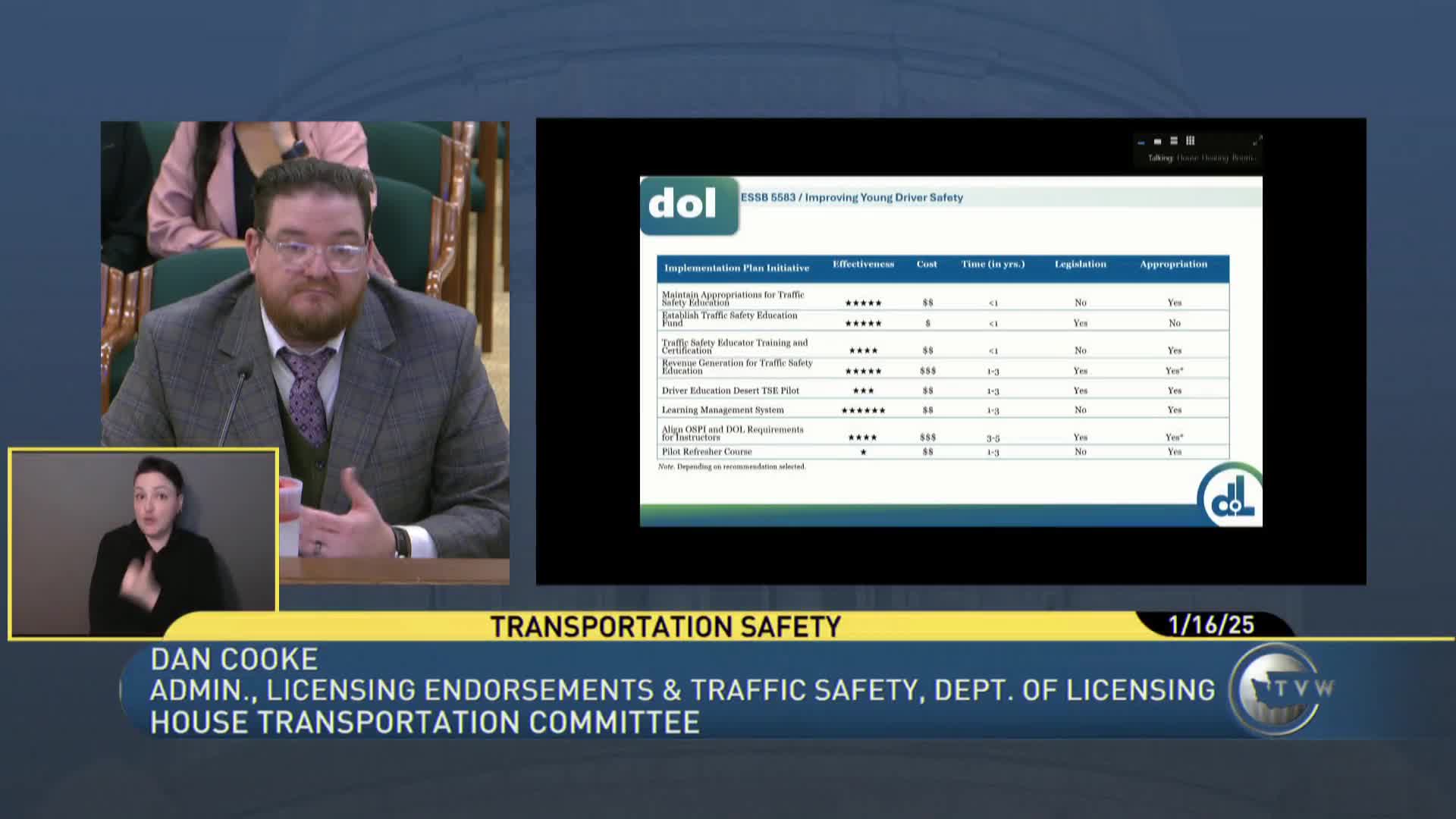State presenter outlines driver-education pilot, proposes phased expansion and shortened instructor training
January 16, 2025 | Health & Long Term Care, Senate, Legislative Sessions, Washington
This article was created by AI summarizing key points discussed. AI makes mistakes, so for full details and context, please refer to the video of the full meeting. Please report any errors so we can fix them. Report an error »

A state presenter told members of a legislative committee that a proposed driver-education pilot could teach three times as many students for roughly one-third of today’s per‑student cost and recommended phased expansion of graduated driver‑licensing requirements for older teens and young adults.
The proposed pilot, described during a presentation and follow-up questions, would combine online and in‑person instruction, create a 10‑week blended instructor training to shorten the current 100‑hour certification requirement, and target areas described as “driver education deserts,” the presenter said. The Department would seek partnerships with public schools, private driver training schools and community and technical colleges to expand capacity, and has discussed the plan with the Office of Superintendent of Public Instruction (OSPI).
Why it matters: state data presented elsewhere in the hearing show fatal crashes and young‑driver involvement have risen in recent years, and committee members pressed the presenter for near‑term legislative steps to scale training and access. Representative Klicker and others said rural constituents face limited access to training and asked how the pilot would avoid replacing existing private providers.
The presenter said the pilot is intended to fill gaps rather than displace the private industry. The presenter also said statutory alignment would be useful: “One of the things that we proposed was bringing the RCWs for in 28A in line with the RCWs in Title 46,” to remove differences in rules for public and private instruction.
Committee members asked for implementation details. Representative Denn asked whether the expansion would apply to ages 18–24 or stop at 21; the presenter described a phased approach that could start at ages 18–19, grow to 21, then to 24 depending on capacity. The presenter estimated a 40% increase in capacity covering ages 18–21, with a further 60% expansion to reach ages 21–24.
On instructor training, the presenter said current statute requires at least 100 hours of theory and practicum to become certified. The pilot will test a 10‑week blended synchronous/asynchronous program plus behind‑the‑wheel practice intended to shorten that pathway and make instructor training easier to deliver through community colleges and existing driver training schools.
Committee members asked for quick, actionable recommendations for the current legislative session. The presenter recommended appropriations to support micro‑grants to public schools and to fund pilot capacity so local districts and rural areas could bring instruction back into high schools.
The presentation and questions spanned public and private delivery models, phased GDL changes, and possible statutory updates; no formal committee action or vote was recorded in the transcript.
The discussion concluded before the committee moved on to the Traffic Safety Commission presentation.
The proposed pilot, described during a presentation and follow-up questions, would combine online and in‑person instruction, create a 10‑week blended instructor training to shorten the current 100‑hour certification requirement, and target areas described as “driver education deserts,” the presenter said. The Department would seek partnerships with public schools, private driver training schools and community and technical colleges to expand capacity, and has discussed the plan with the Office of Superintendent of Public Instruction (OSPI).
Why it matters: state data presented elsewhere in the hearing show fatal crashes and young‑driver involvement have risen in recent years, and committee members pressed the presenter for near‑term legislative steps to scale training and access. Representative Klicker and others said rural constituents face limited access to training and asked how the pilot would avoid replacing existing private providers.
The presenter said the pilot is intended to fill gaps rather than displace the private industry. The presenter also said statutory alignment would be useful: “One of the things that we proposed was bringing the RCWs for in 28A in line with the RCWs in Title 46,” to remove differences in rules for public and private instruction.
Committee members asked for implementation details. Representative Denn asked whether the expansion would apply to ages 18–24 or stop at 21; the presenter described a phased approach that could start at ages 18–19, grow to 21, then to 24 depending on capacity. The presenter estimated a 40% increase in capacity covering ages 18–21, with a further 60% expansion to reach ages 21–24.
On instructor training, the presenter said current statute requires at least 100 hours of theory and practicum to become certified. The pilot will test a 10‑week blended synchronous/asynchronous program plus behind‑the‑wheel practice intended to shorten that pathway and make instructor training easier to deliver through community colleges and existing driver training schools.
Committee members asked for quick, actionable recommendations for the current legislative session. The presenter recommended appropriations to support micro‑grants to public schools and to fund pilot capacity so local districts and rural areas could bring instruction back into high schools.
The presentation and questions spanned public and private delivery models, phased GDL changes, and possible statutory updates; no formal committee action or vote was recorded in the transcript.
The discussion concluded before the committee moved on to the Traffic Safety Commission presentation.
View full meeting
This article is based on a recent meeting—watch the full video and explore the complete transcript for deeper insights into the discussion.
View full meeting
